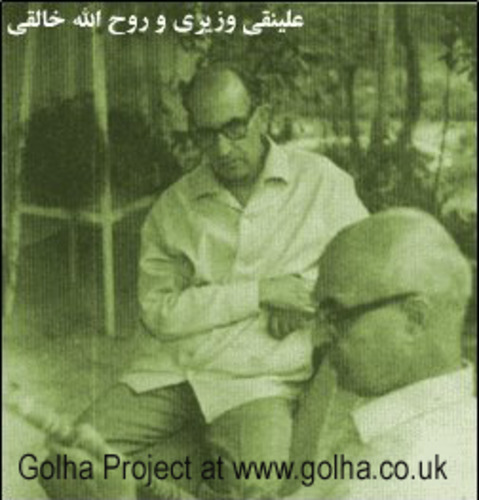Ruhu’llah Khaliqi

Biography
Khaliqi, Ruhu’llah (1906-1965)
Composer, musicologist, theoretician, writer, arranger, conductor, and one of the most influential musicians of twentieth-century Iran. After studying briefly with Mirza Rahim Kamanchihkish and Riza Mahjubi, he found his main and lifelong master in ‘Ali Naqi Vaziri, with whom he studied from 1923 to 1934. In Vaziri’s Academy for the Advanced Study of Music, he learned to play the violin from Vaziri, performed in orchestras, studied music theory as Vaziri taught it, and also worked as a music instructor. Although at the time Persian musicians rarely engaged in academic study, Khaliqi studied and graduated from the university in the field of Persian literature. He also learned the fundamentals of harmony, counterpoint, and orchestration through taking a correspondence course with a French academy of music in Paris.
Khaliqi’s labours in the sphere of Persian music were remarkable, influential, and unique. He played an active role in effecting the course of the development of Persian music in the era following the Constitutional Revolution. His activities include the foundation and supervision of the National Conservatory of Music and its affiliated society and orchestra, his serving on different councils concerning music at the National Radio, working as Editor-in-chief of the Music Magazine (Majalla-yi Musiqi – 1940-1942), the contribution of many articles to different periodicals, the authoring of five volumes of significant reference books on the history and theory of Persian music and lastly, his composition of different forms of Persian music (with or without vocals). In addition one may mention his conduct of research and studies in the domains of classical Persian literature, classical Indian music, and his translation of a number of articles from French and Russian into Persian. Furthermore, Khaliqi rendered incessant services in various other cultural and musical fields: he served on the Music Board of Radio Tehran, he performed constantly in the Golha programmes and he gave a series of brilliant performances in diverse concerts. His patriotic and nationalistic spirit can be vibrantly heard throughout all his compositions, which include, among others, his orchestral arrangements for the compositions of Darvish Khan, ‘Arif, Shayda, Vaziri, Mahjubi, Husayn Yahaqqi, not to mention his own works. When in 1944 Iran was occupied by the Allies, Khaliqi composed what later became known as the Persian national anthem, entitled Ay Iran (“O Iran!”). Husayn Gulgulab (1895-1985) wrote its lyrics and despite many political developments, since it is still the most cherished and perhaps the only national anthem written in the last sixty-five years.
Khaliqi’s wide-ranging and lasting activities in the Golha programmes are to be regarded as having had a supreme impact on the formation and development of these programmes. Although there was some personal differences between Pirnia and Khaliqi (the former preferred literature and poetry over music, and the latter treated literature as secondary to music), their characters, patriotic attitudes, and artistic tastes were otherwise utterly compatible. The idea of the “Golha Orchestra” in fact, was a conception first dreamed up at ‘Ali Naqi Vaziri’s Academy for the Advanced Study of Music; only later, when leavened by mature reflection on the part of Ruhu’llah Khaliqi, coupled with his own scholarship, oeuvre and other music activities, did that seminal idea bear fruit in becoming the Golha orchestra—the supreme manifestation of the national music of Persia. Besides his many arrangements and performances for the Golha programmes, Khaliqi composed a series of first-rate instrumental compositions, the aim whereof was that Persian music attain an independent status of artistic expression and free itself of poetry and singing altogether, thus going beyond being an art of instrumental improvisation and solo performances. Furthermore, it was due to Khaliqi’s pressure and influence that some of the best but normally offstage talents were brought onto the programmes, persuaded to play and provided with artistic, spiritual, and financial support. Among such artists mention may be made of Husayn Tihrani, Murtaza Mahjubi and Husayn Yahaqqi. The demise of Khaliqi, Musa Ma‘rufi, and Murtaza Mahjubi in 1965 and Pirnia’s retirement in 1967 marked the end of a brief but brilliant era of national Persian music, the effects of which will continue to influence Iran’s future. Khaliqi should be considered the master builder of this era when the enduring culture of Persian music was under construction.
His works include: Tarikh-i Musiqi-yi Iran (“The History of Persian Music”), 3 vols.; Nazari bi Musiqi (“A Glance at Music”), 2 vols.; Hamahangi-yi Musiqi (“Harmony in Music”), 1 vol.; 5 CD albums titled Majmu‘a-yi Athar-i Ruhullah Khaliqi (“Collected Works by Ruhullah Khaliqi”), Tehran: Mahur 2004. Golnush khaliqi has also created a website for her fathers works http://www.rkac.com/.